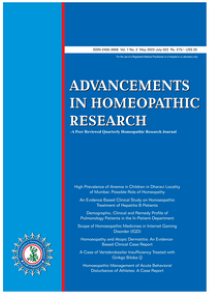Acute Renal Failure: A Case Series (Part 3)
DOI:
https://doi.org/10.48165/ahr.2023.8.4.3Keywords:
Acute renal failure (ARF), serum urea, blood urea nitrogen (BUN), serum creatinine, estimated glomerular filtration rate (eGFR), homoeopathic treatmentAbstract
Acute renal failure (ARF) is sudden reduction of renal function causing accumulation of nitrogenous wastes in blood leading to increased serum urea and creatinine level. In their previous publications Gupta et. al.(4,11,12) successfully demonstrated that majority of patients of chronic renal failure can be improved or at least prevented from further deterioration by homoeopathic treatment. This third case series is on the management of acute renal failure (ARF) by homoeopathic medicines. All the three cases are of drug induced ARF belonging to different age group. The first case is of a 60-year old hypertensive female with parkinsonism and thyrotoxicosis, second of a 24-year hypertensive male and third one is of a 57-year old hypertensive female. In all the 3 cases,repeated renal function test and eGFRcalculatedbyequationfromthe‘Modificationofi’(MDRD) equation (5) considering the age and creatinine, is considered the main parameter to assess the functional status of kidney and response to homoeopathic treatment.
References
Jha V. Current status of end-stage renal disease care in India and Pakistan. Kidney International Supplements 2013; (3): 157-160; doi: 10.1038/ kisup.2013.3. (http://www.nature.com/kisup/journal/ v3/n2/full/kisup20133a.html).
Indian Council of Medical Research, New Delhi. Study on causes of death by verbal autopsy of India 2011; (http://icmr.nic.in/final/causes_death/causes_ death.htm) (accessed 11 December 2011).
Chugh KS, Jha V, Chugh S. Economics of dialysis and renal transplantation in the developing world. Transplant Proc 1999; (31): 3275-3277.
Gupta G, Gupta N, Pandey D, Gupta G. A clinical study on the role of homoeopathic medicines in chronic renal failure patients assessed by estimated glomerular filtration rate (eGFR). National Journal of Homoeopathy Jun 2015 (189th issue); 17(6): 14-
Skorecki K, Green J, Brenner BM. Chronic renal failure. Harrisons Principles of Internal Medicine 2005 16th edition: 1653-1662.
Boericke W. Boericke’s New Manual of Homoeopathic Materia Medica with Repertory. 3rd edition; New Delhi: B Jain Publishers (P) Ltd.; 2007. 60-61, 217, 736-737, 183-186, 998, 1089.
Dal-Ré R, Janiaud P, Ioannidis JP. Real-world evidence: How pragmatic are randomized controlled trials labeled as pragmatic? BMC Med 2018; 16: 1-6.
Ruggenenti P, Cravedi P, Remuzzi G. Mechanisms and treatment of CKD. J Am Soc Nephrol 2012; 23: 1917-1928.
Hanna RM, Ghobry L, Wassef O, Rhee CM, Kalantar Zsdeh K. A practical approach to nutrition, protein energy wasting, sarcopenia, and cachexia in patients with chronic kidney disease. Blood Purif 2020; 49: 202-211.
Braam B, Taler SJ, Rahman M, Fillaus JA, Greco BA, Forman JP, et al. Recognition and management of resistant hypertension. Clin J Am Soc Nephrol 2017; 12: 524-535.
Gupta G, Gupta N, Pandey D, Gupta G. Chronic kidney disease: A case series. Advancements in Homoeopathic Research, Vol. 8, No. 2, May-Jul 2023, pp. 29-34.
Gupta G, Gupta N, Pandey D, Gupta G. Chronic kidney disease: A case series (Part 2). Advancements in Homoeopathic Research (formerly Asian Journal of Homoeopathy), Vol. 8, No. 3, Aug-Oct 2023, pp. 44-49.




